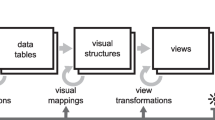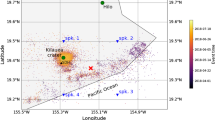Abstract
After only 18 years, the 21st century might already be called the century of data. Internet usage has boomed and terabytes of data are being generated every day. Hence, it comes as no surprise that these data are used in ways other than originally intended. Data visualization as well as data sonification has become a widespread practice for scientific and artistic purposes. In the case of their use in artistic contexts, visualization and sonification are not limited to simply conveying information to users. Artists can use data to control specific elements of their works such as musical or visual parameters, reinterpreting the data, and creating awareness and engagement. In doing so, the artists transform abstract data into an aesthetic experience . This chapter focuses on sonification and discusses some projects that use the pair “data-sound” as a key building block. Looking at these projects, an aesthetic framework for sonification in an artistic context is then proposed.
Access this chapter
Tax calculation will be finalised at checkout
Purchases are for personal use only
Similar content being viewed by others
Notes
- 1.
Looking at the object was not sufficient to grasp its meaning: the audience had to know the concept behind it as well. This was clearly not the case when Canadian customs officials considered the work to be merchandise instead of an original sculpture and wanted to levy a customs duty when the artwork was imported into Canada (Danto 1998).
References
Agostini, A., & Ghisi, D. (2012). Bach: An Environment for Computer-Aided Composition in Max (pp. 1–6).
Barlow, C. (1980). Bus journey to Parametron: All about Cogluotobusisletmesi (Vol. Feedback papers). Cologne: Feedback Studio-Verlag.
Bayer, F. (2000). De Schönberg à Cage. Klincksieck.
Bioacústiques, L. D. (n.d.). LIDO: Listening to the Deep Ocean Environment. Retrieved November 20, 2010, from http://listentothedeep.com/.
Danto, A. C. (1998). Beyond the Brillo box: The visual arts in post-historical perspective (3rd ed.). University of California Press.
de Campo, A. (2008). Toward a data sonification design space map. In G. P. Scavone (Ed.), Presented at the Proceedings of the 13th International Conference on Auditory Display (pp. 343–347). Montréal.
Derivart. (2008, May 30). Spread.player. Retrieved October 2, 2013, from http://www.derivart.es/index.php?s=p7&lang=en.
Devisch, O. (2008). Should planners start playing computer games? arguments from simcity and second life. Planning Theory and Practice, 9(2), 209–226. https://doi.org/10.1080/14649350802042231.
Doornbusch, P. (2005). Pre-composition and algorithmic composition: Reflections on disappearing lines in the sand. Context: Journal of Music Research, 47(29/30).
Ebcioglu, K. (1990). An expert system for harmonizing chorales in the style of JS Bach. The Journal of Logic Programming, 8(1), 145–185.
Fux, J. J. (1965). The Study of Counterpoint from Johann Joseph Fux’s Gradus Ad Parnassum. (A. Mann & J. Edmunds, Trans.). New York: W. W. Norton & Company.
Guljajeva, V., & Sola, M. C. (2011). The Rhythm of City. Geo-located social data as an artistic medium. In Presented at the International Symposium for the Electronic Arts (pp. 1–5). Istanbul.
Harman, S. (2011). Twitter Powered Synthesis. B.Sc. Degree in Music Audio Technology (pp. 1–11).
Hazard, C., Kimport, C., & Johnson, D. (1999, October 1). Fractal Music. Retrieved October 1, 2013, from http://www.tursiops.cc/fm/.
Hermann, T., & Hunt, A. (2004). The importance of interaction in sonification, (pp. 1–8). Retrieved from http://hdl.handle.net/1853/50923.
Johnson, S. (2003). Emergence: The connected lives of ants, brains, cities, and software. New York, United States: Scribner.
Kramer, G. (1994). An introduction to auditory display. In G. Kramer (Ed.), Studies in the Sciences of Complexity Proceedings (Vol. 18, pp. 1–78). Readin, MA: Santa Fe Institute.
Livet, K. (2011, October 2). Radioactive Orchestra. Retrieved October 2, 2013, from http://www.radioactiveorchestra.com/.
Maurer, J. A. (1999, March 1). The history of algorithmic composition. Retrieved October 1, 2013, from https://ccrma.stanford.edu/~blackrse/algorithm.html.
Mazzola, G., Park, J., & Thalmann, F. (2011). Musical Creativity. Berlin, Heidelberg: Springer.
McKay, C. (2002). Final Project Report SpeciesChecker 1.0. Montréal: McGill.
Nussbaumer, S., & Kachel, E. (2007, November 28). Sound Of Mercadolibre—Ubermorgen.Com—Text To Sound Generation—Robots Chaos Structure—Mexico. Retrieved October 2, 2013, from http://www.sound-of-mercadolibre.com/.
Polansky, L. (2002, April 15). Manifestation and sonification. Retrieved September 1, 2013, from http://eamusic.dartmouth.edu/~larry/sonification.html.
Polli, A. (2004). Atmospherics/weatherworks: a multi-channel storm sonification project. In Presented at the Proceedings of the 2004 International Conference on Auditory Display. Sydney.
Quinn, M., & Meeker, L. D. (2001). Research set to music: The climate symphony and other sonifications of ice core, radar, DNA, seismic and solar wind data. In Presented at the Proceedings of the 2001 International Conference on Auditory Display (pp. 56–61), Espoo.
Roden, S. (2012, January 20). Question about Earth.
Roden, S., & Polsenberg, A. (2004). Ear(th). Retrieved from http://ddata.over-blog.com/xxxyyy/1/96/04/42/Textes-1/steve-roden-earth-installation-at-art-center.pdf.
Saladin, M. (2007). Stock Exchange Piece. (Mattin, Ed.) mattin.org w.m.o/r (32nd ed., Vol. 50).
Sodell, J., & Soddell, F. (2005, December 28). Microbes, L-systems and music. Retrieved October 1, 2013, from http://cajid.com/jacques/lsys/index.htm.
Schottstaedt, B. (1984). Automatic species counterpoint (No. STAN-M-19). CCRMA reports (p. 70). Stanford. Retrieved from https://ccrma.stanford.edu/files/papers/stanm19.pdf.
Supper, M. (2001). A Few Remarks on Algorithmic Composition, 25(1), 48–53. https://doi.org/10.1162/014892601300126106.
Taube, H. (2004). Notes from the Metalevel: An Introduction to Computer Composition. London, UK: Routledge.
Thomas, A. M. P. (2012, January 20). Question about the Earth work with Steve Roden.
Van Ransbeeck, S. (2015). Transforming the Stock Markets into Music using DataScapR, 7(4), 1–12. Retrieved from http://piim.newschool.edu/journal/issues/2015/04/index.php.
Van Ransbeeck, S., & Guedes, C. (2009). Stockwatch: A tool for composition with complex data. Parsons Journal for Information Mapping, 1–3.
Walker, B. N., & Nees, M. A. (2011). Chapter 2 Theory of Sonification. In T. Hermann, A. Hunt, & J. G. Neuhoff (Eds.), The Sonification Handbook (pp. 9–39). Berlin, Germany: Logos Verlag.
Worrall, D. (2009). Sonification and information. In Sonification and Information: Concepts, Instruments and Techniques. Canberra, Australia.
Acknowledgements
I would like to thank my supervisor António de Sousa Dias for his continuous (incremental!) revisions and careful guidance in writing this chapter. This research is sponsored through a Ph.D. scholarship by the Portuguese Foundation for Science and Art with reference SFRH/BD/72601/2010.
Author information
Authors and Affiliations
Corresponding author
Editor information
Editors and Affiliations
Rights and permissions
Copyright information
© 2018 Springer Nature Singapore Pte Ltd.
About this chapter
Cite this chapter
Van Ransbeeck, S. (2018). Sonification in an Artistic Context. In: Cermak-Sassenrath, D. (eds) Playful Disruption of Digital Media. Gaming Media and Social Effects. Springer, Singapore. https://doi.org/10.1007/978-981-10-1891-6_10
Download citation
DOI: https://doi.org/10.1007/978-981-10-1891-6_10
Published:
Publisher Name: Springer, Singapore
Print ISBN: 978-981-10-1889-3
Online ISBN: 978-981-10-1891-6
eBook Packages: Literature, Cultural and Media StudiesLiterature, Cultural and Media Studies (R0)




